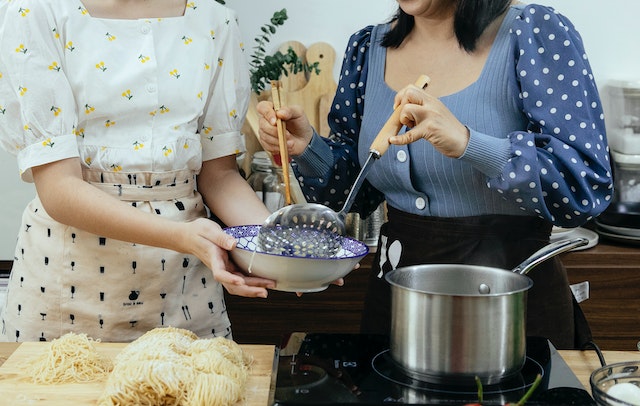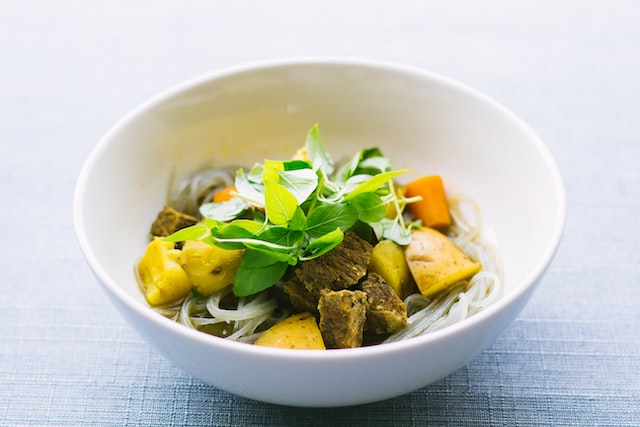Traditional wheat-based noodles have recently seen a surge in popularity in comparison to potato noodles. These gluten-free noodles have a distinct texture and taste that set them apart from other kinds of noodles. They are also made from potato starch, which gives them their gluten-free status. In this post, we will discuss all you need to know about potato noodles, including their history, nutrition, and how to prepare them in various dishes.
History of Potato Noodles
Potato noodles, which are often referred to as sweet potato noodles, may be traced back to China and Korea. Historically, they were prepared by first cooking sweet potatoes, and then crushing the cooked potatoes into a fine powder. After that, the starch that had been produced was combined with water and rolled into noodles.
These days, sweet potato starch is not used in the production of potato noodles; instead, potato starch is used. In order to get starch from potatoes, first the potatoes must be crushed and washed, and then the starch must be allowed to settle and dry. When the dried starch has been dried completely, it is next crushed into a fine powder that is utilized in the manufacturing of the noodles.
The Dietary Value of Potato Noodles
There are around 80 grams of carbs in every one hundred grams of potato noodles, making them a valuable supply of this macronutrient. In addition to this, they include a minimal amount of fat, with just roughly 0.1 grams of fat per 100 grams of noodles. Since they do not contain gluten, potato noodles are an excellent alternative for those who suffer from celiac disease or are sensitive to gluten.
Potato noodles provide roughly one gram of protein per one hundred grams of noodles, which is a relatively low amount of protein compared to other types of noodles. This is one possible drawback of potato noodles. On the other hand, this problem is readily solvable by include in your potato noodle meal certain components that are high in protein, such as tofu, chicken, or beef.
Cooking Potato Noodles

Potato noodles may be prepared using a number of cooking methods, such as boiling, stir-frying, or deep-frying. The following are some helpful hints for preparing potato noodles:
- The first step in boiling potato noodles is to bring a pot of water to a boil, then add the noodles after the water has reached a rolling boil. Noodles should be cooked for around seven to nine minutes, or until they reach the desired tenderness. To halt the cooking process, drain the noodles and then briefly submerge them in a bowl of ice water.
- Preheat a wok or a skillet over high heat, then add oil to the pan. This will allow you to stir-fry potato noodles. After adding the veggies and protein of your choice to the pan, stir-fry them for a few minutes until they reach the appropriate doneness. Once the potato noodles have been cooked, add them to the pan and continue to stir-fry for another minute or two until they have reached the desired temperature.
- Fry the potato noodles in hot oil in a deep-fryer or a heavy-bottomed saucepan by first heating the oil. Fry the potato noodles in the heated oil until they are golden brown and crispy all the way through. Before serving, the noodles should be drained on paper towels.
Options for Alternate Preparations and Ideas for Presenting Potato Noodles
Potato noodles are an adaptable component that may be used in a wide range of culinary preparations. The following is a list of alternative preparations and serving ideas for potato noodles:
- Soup with potato noodles may be made by substituting potato noodles for the usual noodles called for in the soup recipe you normally use. They perform well in a variety of soups, including chicken noodle soup, vegetable soup, and others.
- To make the energizing and satisfying salad, toss cooked potato noodles with the salad greens and vegetables of your choice, along with the dressing of your choice.
- Give your go-to stir-fry meal an interesting new twist by substituting potato noodles for the traditional rice noodles called for in the recipe.
- In lieu of rice noodles, you may use potato noodles in your favorite pad Thai dish. The tastes of the pad Thai sauce, which are sour and spicy, go really well with the potato noodles, which have a flavor that is somewhat sweet.
- For a substantial and reassuring supper, you may make a potato noodle casserole by layering cooked potato noodles with veggies, meat, and sauce in a casserole dish.
When you serve potato noodles, you may want to think about adding toppings like sesame seeds, chopped scallions, or cilantro for some more flavor and texture. To add even more flavor to your meal, you may finish it off with a few drops of sesame oil or a few drops of fresh lime juice.
Advantages of Using Potato Noodles
Potato noodles have a variety of other health advantages, in addition to not containing gluten and having a low total fat content. They have a high concentration of a form of starch known as resistant starch, which is resistant to digestion and may contribute to improved gut health. Moreover, resistant starch has a lower glycemic index in comparison to other forms of starch, which indicates that it may assist in the regulation of blood sugar levels.
In addition, potato noodles are an excellent source of potassium, a mineral that plays a significant role in the regulation of blood pressure and the proper functioning of the heart. There are around 125 mg of potassium in one cup of potato noodles, which is approximately 3% of the daily potassium consumption that is recommended.
Last but not least, potato noodles are an excellent option for folks who have difficulty digesting other foods since they are simple to break down and are easy on the stomach.
Conclusion
The typical noodle may be replaced with a tasty and more wholesome option like potato noodles. They do not contain gluten, have a low total fat content, and are an excellent source of resistant starch and potassium. Potato noodles may be prepared in a number of ways, such as by boiling, stir-frying, or deep-frying, and they can be used in a range of recipes, such as soups, salads, stir-fries, and casseroles. Some of the cooking methods that can be used are listed below. Potato noodles are a delicious and versatile addition to any cuisine because of their one-of-a-kind consistency and taste.

